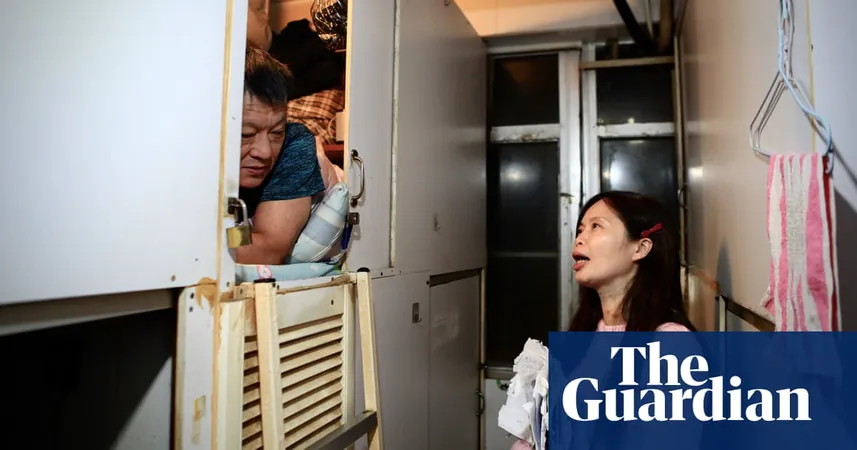
Hong Kong's Housing Crisis: Are 'Coffin Homes' Here to Stay Amidst New Reforms?
2025-01-03
Author: Yan
Introduction
In the bustling heart of Mong Kok, Hong Kong, social worker Lai Shan Sze navigates the dimly lit staircases of a crowded apartment building. She knocks on doors, checking in on the residents of what are notoriously known as “coffin homes”—tiny living quarters so compact they redefine the meaning of cramped living. These micro-units house multiple tenants, often offering little more than the size of a single mattress, stacked precariously to maximize space.
The Human Impact
As Sze gathers information on the residents, she meets a woman who moved from Shenzhen, revealing the deep emotional toll of such living conditions. “I worry that my family will be embarrassed if they see what I’m living in here,” she confides, highlighting the stigma surrounding such housing in a city known for its exorbitant cost of living.
Government Regulations and Their Shortcomings
Despite Hong Kong’s renown for tiny apartments, the government's recent attempt to address the dire housing situation seems to fall short. New regulations aim to improve living conditions by the end of 2026, but critics argue these reforms fail to adequately target the most severe cases—namely, coffin and cage homes that house the city’s most vulnerable populations.
Current Living Conditions
According to recent studies, regular subdivided units (SDUs) average only 13 square meters, often accommodating entire families. Meanwhile, coffin homes and cage homes, a similar concept constructed from wire, continue to thrive in the shadows, with over 200,000 residents currently living in these cramped conditions. Landlords exploit the situation, commanding high rents that often surpass the cost of regular apartment rentals, making Hong Kong infamous for its lack of housing affordability.
Pressure from Beijing
The government's push for change has intensified in light of pressure from Beijing, which emphasizes the need to resolve 'deep-rooted problems' in housing. In a bold initiative, the administration plans to establish a minimum space requirement of 8 square meters for SDUs, including essential amenities like proper windows and private toilets. Yet, with such a meager increase—only a single square meter over the size of a prison cell—many question its adequacy for families and the more than 50,000 children who reside in SDUs.
Concerns Over Regulation Enforcement
To add insult to injury, critics express concern that the new regulations won’t extend to coffin and cage homes, which remain governed by outdated ordinances. Activists emphasize that without stricter enforcement, the government's dreams of eradicating 'low-quality' housing are unlikely to become a reality.
Fear of Increased Rents
As Sze speaks with residents, she finds many living in unregistered placements—landlords often neglecting their responsibilities. These small, oppressed communities fear that potential improvements to their living spaces could trigger rent increases, making their already precarious situations even worse. Hong Kong legislator Michael Tien warns that better conditions will likely lead to higher rents, leaving individuals like Lau, a street cleaner who has lived in a coffin home for a decade, caught in a cycle of poverty and uncertainty.
Public Housing Needs
With approximately 308,000 new public housing units desperately needed in Hong Kong, the government’s promise of 43,600 new flats by 2030 seems like a drop in the bucket against a waitlist exceeding five years and nearly 200,000 applicants. The administration claims that 60% of SDU residents qualify for public housing, yet their assurances ring hollow for those who have been left behind.
Conclusion
Coco, who has lived in an SDU for 24 years, expresses her skepticism succinctly: “The government can say what they want, but can they really do it?” The transition from shoddy accommodations to decent housing remains fraught with challenges, and many doubt the government's ability to deliver on its promises.
In a city where housing conditions are often a living nightmare for many, the looming question is: will the government truly tackle the housing crisis, or will 'coffin homes' continue to plague Hong Kong's skyline? Stay tuned as this story develops—and find out how it could impact thousands trapped in the city’s housing labyrinth.

 Brasil (PT)
Brasil (PT)
 Canada (EN)
Canada (EN)
 Chile (ES)
Chile (ES)
 Česko (CS)
Česko (CS)
 대한민국 (KO)
대한민국 (KO)
 España (ES)
España (ES)
 France (FR)
France (FR)
 Hong Kong (EN)
Hong Kong (EN)
 Italia (IT)
Italia (IT)
 日本 (JA)
日本 (JA)
 Magyarország (HU)
Magyarország (HU)
 Norge (NO)
Norge (NO)
 Polska (PL)
Polska (PL)
 Schweiz (DE)
Schweiz (DE)
 Singapore (EN)
Singapore (EN)
 Sverige (SV)
Sverige (SV)
 Suomi (FI)
Suomi (FI)
 Türkiye (TR)
Türkiye (TR)
 الإمارات العربية المتحدة (AR)
الإمارات العربية المتحدة (AR)